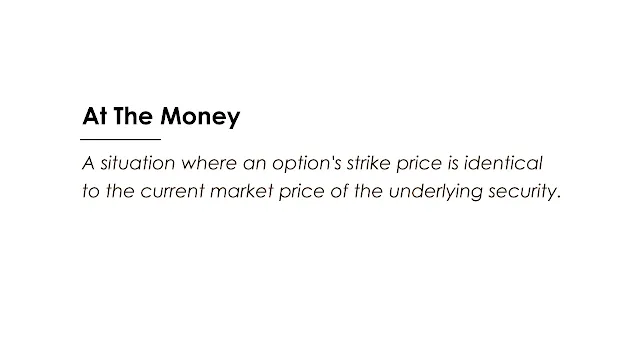 |
| Image: Moneybestpal.com |
An option is considered to be "at the money" (ATM) when its strike price coincides with the underlying security's current market price. An option is a contract that grants the buyer the right—but not the obligation—to buy or sell the underlying asset at a given price (the strike price) on or before a given date (the expiration date), with or without modification. Stocks, commodities, currencies, indexes, and other financial instruments are all acceptable forms of the underlying asset.
Although an ATM option has no intrinsic value, it nevertheless has time value before it expires. If it is advantageous for the option holder, intrinsic value is the difference between the market price and the strike price of an option. Extrinsic value, which is determined by variables like time till expiration, volatility, interest rates, and dividends, is the amount that an option buyer is willing to pay for an option above and above its inherent value.
ATM allows for the simultaneous use of call and put options. The buyer of a call option has the option to purchase the underlying asset at the strike price, whereas the buyer of a put option has the option to sell the underlying asset at the strike price. For instance, both the XYZ 75 call option and the XYZ 75 put option are ATM if the price of the XYZ stock is $75.
Based on its moneyness, or the correlation between an option's strike price and the price of the underlying security, ATM options are one of three categories of options. Options that are in-the-money (ITM) and out-of-the-money (OTM) are the other two categories.
ITM denotes the ability to exercise an option profitably and the existence of intrinsic value. When the striking price of a call option is less than the market value of the underlying asset, the option is in the money (ITM), whereas the strike price of a put option is larger than the market value of the underlying asset.
An option is said to be OTM if it has no intrinsic value and cannot be profitably exercised. When the striking price of a call option is higher than the market value of the underlying asset, the option is out-of-the-money (OTM), whereas the strike price of a put option is lower than the market value of the underlying asset.
How Does ATM Work in Options Trading?
Traders frequently employ ATM options to create spreads and combinations. Purchasing and selling options of the same type (calls or puts) with various strike prices or expiration dates is known as a spread. Buying and selling options of various types (calls and puts) and with various strike prices or expiration dates is the strategy known as a combination.
A straddle is a type of spread that makes use of ATM options. The purchase (or sale) of an ATM call and an ATM put with the same strike price and expiration date is known as a straddle. Regardless of whether the price of the underlying asset increases or decreases, the trader can benefit from a big price fluctuation using this method.
A strangle is another combination that makes use of ATM options. A strangle is when a call and a put with separate strike prices and the same expiration date are both purchased (or sold). This trading method also enables the trader to profit from a sizable price movement of the underlying asset in either direction, but it necessitates a larger swing than a straddle to break even.
ATM options are also appealing to investors who anticipate considerable price volatility in the underlying asset. The degree to which an asset's price changes over time is gauged by its volatility. Low volatility denotes minor price movements, and high volatility denotes significant price changes.
Gamma, one of the risk factors that influence an option's pricing, is present in the highest concentration in ATM options. Gamma quantifies how much the price of the underlying asset affects the delta of an option. The term "delta" refers to how much the price of an option fluctuates when the value of the underlying asset changes.
Delta for ATM options is 0.50, which is positive for calls and negative for puts. This implies that the price of an ATM option will move by $0.50 in the same direction for every $1 change in the price of the underlying asset. However, an ATM option's delta will quickly change when the price of the underlying asset moves away from the strike price, becoming closer to 1.00 for ITM options and to 0 for OTM options.
As a result, ATM options are particularly susceptible to changes in the price of the underlying asset and will swiftly gain or lose value as the price changes. Because of this, traders who anticipate high volatility can either buy ATM options to profit from significant price changes or sell ATM options to earn a premium from high extrinsic value.
Summary
- An option is considered to be "at the money" (ATM) when its strike price coincides with the underlying security's current market price.
- Despite having no inherent value, an ATM option will nonetheless be worth something before it expires.
- There are currently simultaneous call and put options available.
- In terms of moneyness, ATM options, along with in-the-money (ITM) and out-of-the-money (OTM) choices, are three different sorts of options.
- ATM options are frequently employed by traders to build spreads and combinations, such as straddles and strangles, that can profit from significant price swings in either direction of the underlying asset.
- With the highest gamma values, ATM options are the most susceptible to changes in the volatility and price of the underlying asset.
